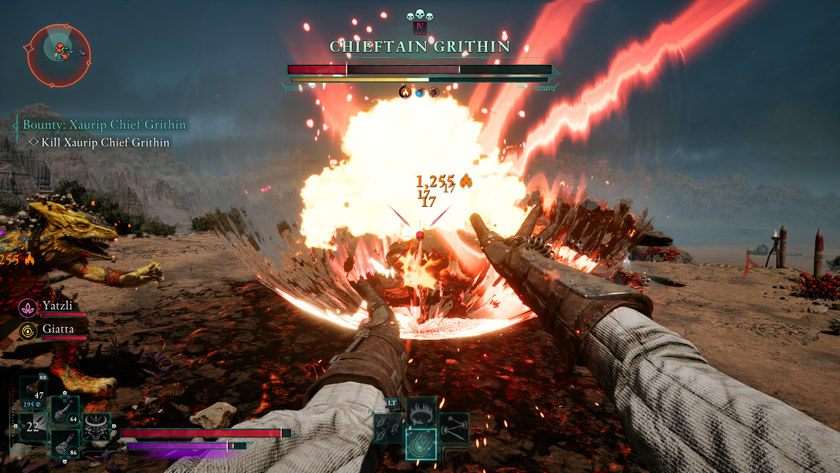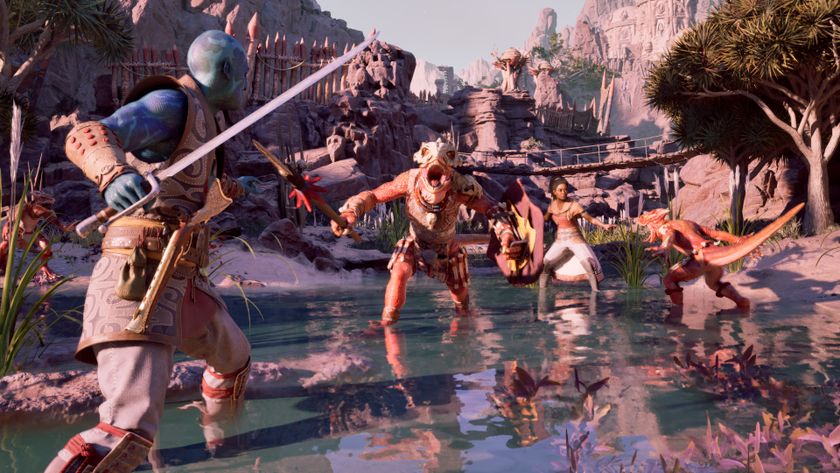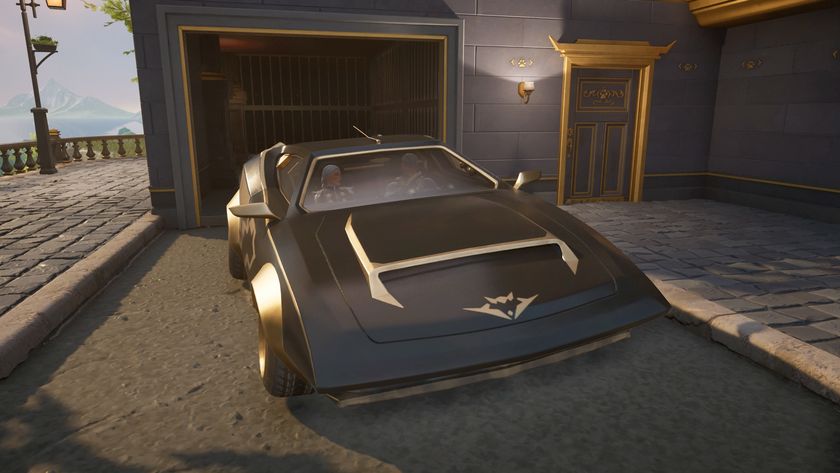12DOVE Verdict
While The Ascent is a true visual showcase for the Xbox Series X, it lacks depth and clarity. There's a fun game in here, but it's ultimately overburdened.
Pros
- +
Incredible visual design
- +
Fun encounters
- +
Tight gunplay
Cons
- -
Incomprehensible narrative
- -
Poor communication
- -
Difficulty spikes
Why you can trust 12DOVE
The Ascent is at its best when you're standing still. When you're peering off the edge of the world, out at the neon-tinged arcology that encompasses the chaos unfurling around you. Sometimes, the camera will reel in from the sky towards some distant detail – plumes of smoke twisting in the wind, gears turning beneath some towering structure – and in closer to your character, who'll be wearing an uncoordinated ensemble of whatever high-stat crap you've been able to scavenge from corpses. It's in these moments that The Ascent is able to capture a feeling of awe many would have felt with Final Fantasy 7, when a generation of players walked the Midgar Slums in the autumn of '97 and were warmed by the sheer scale of the Upper Plate Sectors – the pre-rendered backgrounds teasing a realm of unprecedented depth and detail.
It's only as you begin to move that the illusion is shattered. The Ascent is a beautiful, hollow thing. Developer Neon Giant has been able to establish an impression of scale throughout its environment that is truly impressive, an achievement that brings The Ascent to life on Xbox Series X with the sort of dynamic lighting, shadowing, and detailing that'll easily justify the purchase of your 4K HDR-ready television. It also feels like an artificial creation that could collapse around you at any moment. A gust of wind could blow through and reveal the planet of Veles to be little more than an expertly-crafted film set, a bank of production staff hiding behind the cardboard staging to start up the next scene of twin-stick destruction.
Moving up in the world


Release date: July 29, 2021
Platform(s): PC, Xbox Series X
Developer: Neon Giant
Publisher: Curve Digital
Where games like Alienation or Hunter: The Reckoning would typically move you from one level to the next, The Ascent is more like Diablo 3 – or The Legend of Zelda, were we feeling particularly generous – in that it places you in a sprawling world and is happy to leave you to your own devices. The multi-tiered world is open to exploration, connected by Mass Effect-style elevators, level-gated by waves of incessantly bland mercenaries, so that you can go off in search of the resources needed to upgrade weapons and purchase increasingly absurd augmentations should you want to. The Ascent wants you to believe that you're making your own way through a complicated capitalistic hellscape, where the poor are forced to live in the literal shadow of the rich and powerful; a cyberpunk world that is overcrowded with an array of colorful characters.
The problem The Ascent faces is that your only point of interaction with the world around you is with whatever gun is held in hand. The areas you navigate are densely populated but ultimately lifeless. The animated bodies that occupy the streets and hubs of commerce pop in and out of existence and barely react to your presence, as if they are background actors paid only to compose themselves quickly should you shoulder-barge them and flee at the first sound of gunfire. A handful of NPCs will offer side-quests, but these routinely end without any real resolution. Bounties can be handed in to shopkeepers, but they offer no further detailing to the type of villains running amok through the colony. The characters entrusted to drive the main story forward – rare voices in a wall of disorienting sound – are little more than ciphers designed to deliver incomprehensible genre talk.
While the game may look like something that emerged from the mind of Ridley Scott, The Ascent is more Bright than Blade Runner. Put a gun to my head, I wouldn't be able to recall a single plot point, character name, or acronym. As you set off between areas of the world at the command of caustic mob bosses and agency heads to put bullet holes in bodies, you'll be doing so for reasons that rarely make sense. It doesn't help that the characters are all grossly unlikeable at best, and weirdly juvenile at worst – an early quest called 'Balls Deep' sets the tone for the type of storytelling that only a teenager could truly appreciate.
Guns blazing

How easily you're able to disassociate yourself from the driving forces of the narrative will likely define how well you get on with The Ascent. It's a competent action-RPG, with tight twin-stick shooting and intuitive controls. There's real joy to be had in pushing into groups of enemies and kiting them around the isometric 3D spaces, quickly switching between your two primary weapons to deal out maximum damage and ducking behind cover when you need to figure out which of your cooldowns are ready to be unleashed – stasis grenades that hold enemies in place, an exoskeleton mech suit that can be summoned to give you some additional firepower, a barrage of micro-missiles that can be unleashed from your shoulder blades, or devastating melee attacks that rupture the ground around you.
Cover provides added depth to combat too, as the left trigger can be used to introduce elevation to your shooting patterns. If you duck behind some waist-high object you can squeeze the left trigger to tease your weapon up over it, staggering encroaching enemies and gathering yourself before the next wave is activated off-screen. You'll need to think cleverly about opportunities like this, particularly as you approach boss rooms. It's in these areas where the difficulty spikes become a little unmanageable for solo players, more so than in online or couch co-op, as the screen fills with enemy variants and every inch of the environment becomes awash with ballistic and elemental gunfire.
It's here where The Ascent is both at its best and its most frustrating. When you get the rhythm of the encounter right, the game quickly feels like a product of Housemarque, delivering the sort of highs and lows that you'd typically associate with Alienation or Nex Machina. At its worst, when you're getting caught on pieces of the environment or seeing absurd waves of challenging enemies pour in all at once, you'll find some frustration in death because of the way the game handles checkpointing and replenishment of equipment, energy, and HP.
As fun as the gunplay can be, there's a surprising lack of weight to it. Whether you're holding a machine gun, precision rifle, rocket launcher, or multi-barrel shotgun, the weapons feel largely the same. This is, partly, down to them having no rumble patterns; given the variety, weapons could really have done with some of the love that Insomniac bestowed upon Sunset Overdrive, making every firearm feel distinct underfinger. It was also surprising that Neon Giant used a pulse of the Impulse Triggers on the Xbox Series X controller to signal the recharge of Tactical Equipment, rather than weapons extinguishing their ammunition (like in Gears 5). There were a few instances during calamitous encounters where I was in the throes of destruction only to find my character running backwards without firing, tens of enemies bearing down on me, having missed the quiet visual and audio prompts to reload the damn thing – you need to release the trigger before replenishment will activate.
Communication breakdown

Truth be told, The Ascent has a problem with communication. Not just in the way it presents its characters, tells its story, or instructs vital information in combat, but in the way it presents core ideas. There are plenty of opportunities to upgrade your character's multitude of proficiencies, but I don't think I ever truly understood what I was improving and how it was benefiting me in a tangible sense. Weapons and armor come primed to work and defend against differing elemental resistances, but the game does a poor job of explaining whether you're properly equipped for the job – I only knew one type of weapon worked better against a certain type of enemy when an Achievement popped to celebrate the combination. This information is squirreled away in the menus but the text size is tiny, making it difficult to parse on a TV situated far from the couch.
Mercifully, subtitle text can be increased, but that's only half the battle. In fact, there's a lot of little factors that make The Ascent feel like a game that was built for PC – despite being positioned as an Xbox Series X showcase from its reveal. The menus are finicky and difficult to navigate. The map does a poor job of showing where points-of-interest are around you and is even worse at signaling side-quest opportunities once you've accepted them, leading to a lot of needless backtracking – movement speed is so debilitatingly slow that you'll soon resort to using fast travel to get around. The problems with the map are compounded in the main hub areas; they are beautiful, bustling little areas, but they can also be truly disorienting – noisy with visual and audio cues – which plays into The Ascent's cyberpunk grounding, yes, but that doesn't make them fun to parse through when you're quickly looking for a vendor or particular NPC.
The Ascent is a beautiful-looking game that feels overburdened by ambition. The scale of its world is grand but there's little of interest to do in it. It's densely populated with characters, but few have little of interest to say and even less have a reaction to the way your actions are impacting their reality. The combat is tight to control but has little in the way of real variation. If you were able to gather a few friends with an Xbox Game Pass subscription and blast through The Ascent over a few evenings, you'll likely have a good time, just don't come here expecting a cyberpunk world that you can invest any of yourself in.
The Ascent was reviewed on Xbox Series X, with code provided by publisher.

Josh West is the Editor-in-Chief of 12DOVE. He has over 15 years experience in online and print journalism, and holds a BA (Hons) in Journalism and Feature Writing. Prior to starting his current position, Josh has served as GR+'s Features Editor and Deputy Editor of games™ magazine, and has freelanced for numerous publications including 3D Artist, Edge magazine, iCreate, Metal Hammer, Play, Retro Gamer, and SFX. Additionally, he has appeared on the BBC and ITV to provide expert comment, written for Scholastic books, edited a book for Hachette, and worked as the Assistant Producer of the Future Games Show. In his spare time, Josh likes to play bass guitar and video games. Years ago, he was in a few movies and TV shows that you've definitely seen but will never be able to spot him in.






















